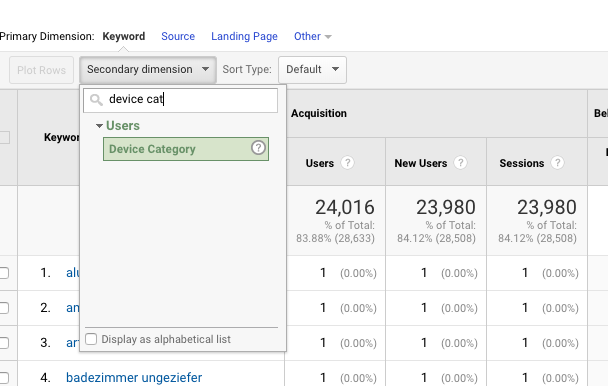Comprehensive Insights Using Secondary Dimension in Google Analytics
Transform Your Analytics Approach With Second Dimension in Google Analytics
By integrating additional dimensions right into data analysis, a new layer of understandings emerges, shedding light on complex user habits and communications. The calculated application of second dimensions holds the vital to unlocking a treasure chest of important details that can change exactly how companies act and interpret upon their data.
Comprehending Second Dimensions in Google Analytics
Additional measurements in Google Analytics provide extra context to key data by enabling customers to assess metrics across a second measurement, providing much deeper understandings into user actions and communications on a website. Secondary Dimension in Google Analytics. While main measurements give fundamental data points such as pageviews, bounce price, and session period, additional measurements supply an even more detailed view by segmenting the main information better. This division allows individuals to assess metrics in mix with another dimension, such as traffic sources, demographics, or individual habits
Benefits of Using Additional Measurements
Using secondary measurements in Google Analytics uses a critical advantage by boosting the deepness of analysis and providing a much more detailed understanding of individual interactions and habits on an internet site. By including second measurements, experts can get useful insights into the performance of specific segments or variables within their information. This makes it possible for a much more in-depth assessment of individual behavior past surface-level metrics, allowing for a much deeper expedition of the elements affecting user interaction and conversions.

How to Apply Additional Measurements
When integrating secondary dimensions in Google Analytics, one crucial step is to pick the relevant metrics and measurements to enrich the evaluation procedure. To execute second dimensions successfully, start by accessing your Google Analytics account and navigating to the record you want to enhance with extra information. Once in the report, situate the "Secondary Dimension" switch, generally found over the data table. Clicking on this switch will certainly open a drop-down menu listing different dimensions that can be contributed to your primary dimension for deeper understandings.
After choosing the proper second measurement, such as 'Source/Medium' or 'Tool Classification,' Google Analytics will certainly present the information in an extra comprehensive style, enabling you to cross-analyze different elements of individual habits. Keep in mind to trying out various mixes of second and key measurements to reveal beneficial patterns and trends that can educate your advertising approaches. By applying second measurements attentively, you can get a much more detailed understanding of your web site or app performance and make data-driven decisions to maximize your electronic existence.
Studying Data With Second Measurements
Boost your information analysis in Google Analytics by including secondary measurements to delve much deeper right into user actions patterns and enhance your digital marketing approaches successfully - Secondary Dimension in Google Analytics. By adding secondary measurements to your main information, you can obtain important understandings that can assist you make informed choices concerning your internet site or app efficiency
Examining data with additional dimensions enables you to segment your main information even more, providing an extra extensive sight of user communications. Incorporating the main measurement of 'source/medium' with a secondary dimension like 'touchdown web page' can reveal which certain web pages are driving traffic from various resources. This information can be critical in improving your content method or maximizing your marketing projects to raise conversions.
Moreover, making use of second dimensions enables you to determine relationships in between different metrics, helping you comprehend the effect of numerous factors on user behavior. Whether it's examining demographics alongside customer engagement metrics or device categories with conversion i loved this rates, additional measurements empower you to uncover covert patterns and patterns that can assist your advertising and marketing initiatives.
Maximizing Efficiency With Second Measurements
To boost the performance of data evaluation and decision-making in Google Analytics, integrating second dimensions is crucial to enhancing efficiency metrics and obtaining much deeper understandings right into customer actions patterns. By using additional dimensions, analysts can delve past surface-level information and YOURURL.com discover useful relationships that may otherwise go unnoticed. This optimization strategy enables businesses to customize their advertising and marketing initiatives a lot more efficiently, identify locations for renovation in web site functionality, and improve overall customer experience.
Second dimensions provide an even more detailed view of customer communications by supplying extra context to primary information metrics. Combining the primary measurement of 'landing page' with a second dimension like 'device category' can disclose whether certain tools are much more most likely to drive interaction on details landing web pages. This insight can notify responsive style improvements or targeted marketing techniques to enhance performance.

Final Thought
In conclusion, the assimilation of additional measurements in Google Analytics supplies companies with an effective tool to boost their analytics method. Secondary Dimension in Google Analytics. By delving deeper right into user habits and interactions, marketers can discover valuable understandings that can drive efficiency optimization and enhance the total individual experience. Leveraging second dimensions permits for a more detailed evaluation of information, causing more educated decision-making and customized advertising initiatives
Secondary dimensions in Google Analytics give extra context to key data by enabling customers to analyze metrics across a 2nd measurement, offering deeper understandings right into user habits and communications on a website. While main measurements give fundamental data points such as pageviews, bounce rate, and session period, second dimensions use an even more comprehensive view by segmenting the main information further.One of the essential advice benefits of utilizing additional measurements is the capacity to uncover correlations and patterns that may not be quickly apparent when evaluating data with main measurements alone.When including second measurements in Google Analytics, one essential step is to choose the relevant metrics and dimensions to enhance the evaluation procedure. Matching the key measurement of 'landing page' with a secondary dimension like 'device category' can reveal whether certain gadgets are a lot more most likely to drive interaction on certain landing pages.